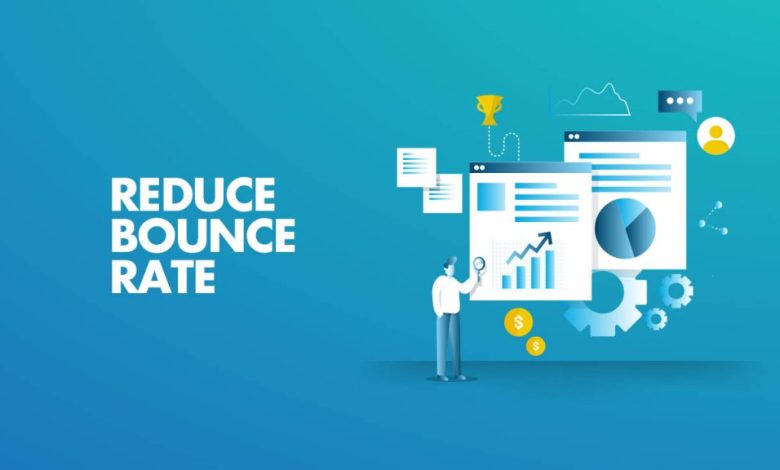9 Factors for Maintaining a Website’s Bounce Rate

Websites are key to analyze any businesses online growth. Businesses can do this with the help of various elements.
One of that element is a website’s bounce rate. Bounce rate is one of the many internet marketing term used in web traffic analysis just like exit rate etc.
This article teaches all there is to learn about bounce rate. What it is? How it effects a business and how we can maintain it?
What is a Bounce Rate?
Bounce Rate is the percentage of visitors that leave a webpage without taking an action, such as clicking on a link, filling out a form, or making a purchase.
Google takes bounce rate into account when ranking page in search engine results. SEO professionals are obsessed with lowering the bounce metric. They believe it will improve their search engine ranking however, this may not be the case every time.
For this reason, it is important that even if brands are to outsource web development services they should remember the factors discussed in this article. Keep in mind to only go for the best branding services and UI/UX Web developers like Digitrends.
What do Bounce Rates Tell You?
This is the tricky part!!!
A 100% bounce rate on a specific page, may not always be a negative. Frequently, visitors find the answers they seek and decide to exit out of the page.
Analyzing what the bounce rate of a website is telling can be a little tricky. Perhaps, this is the reason why many webmasters fail to read it and improve their websites accordingly.
Generally, a high bounce rate may be bad for your website. It shows that the content and structure of a website is not engaging enough to hold the attention of the visitors.
However, sometimes, numbers may lie.
What is a Good Bounce Rate?
As a rule of thumb, a bounce rate in the range of 26 to 40 percent is excellent. 41 to 55 percent is roughly average while 56 to 70 percent is higher than average, but may not be cause for alarm depending on the website.
The ‘goodness’ of the bounce rate depends on the niche a business is in.
Bounce rate can go as low as 35 – 40% in some niches. Conversely, it is not very uncommon to have a bounce rate as high as 80% in other niches. All in all, it depends on the specific niche a business is in.
Generally speaking, if you have a publishing website with lots of blog posts, a bounce rate of around 70% would be fine but that might not hold true for a tech website
3 Reasons to Utilize Bounce Rate
Bounce Rate is important for three main reasons:
- If a visitor bounces from a site it does not convert. It is an indicator to stop a visitor from bouncing and increases the conversion rate.
- Bounce rate is closely correlated to first page Google rankings and generally used as a Google ranking factor.
- A high bounce rate evidently informs if a site has issues with content, user experience, page layout or copywriting.
9 Things That Affect a Site’s Bounce Rate
It is not very wise to set a certain number to what a good bounce rate is. However it is essential to know the basic factors that can increase of decrease the bounce rate.
Brands should ensure that they collaborate with best digital marketing company and efficient SEO service providers like Digitrends who understands what their customers’ needs and require.
Absence of CTAs
Calls to action are often an overlooked component, they carry much of the weight of a website’s high bounce rate.
In brief, ensure that a visitor takes action with the help of visually attracting CTAs known on a website.
For the same reason the right call-to-action words will help bring down the bounce rate. Here are 10 powerful CTA words to consider using.
- Sign Up Free
- Read More
- Create Account
- Explore Related Articles
- Book a Demo
- Contact Sales
- Learn More
- Join For Free
- Subscribe
It’s also important you create visually identifiable call to action buttons on your website which help to navigate your audience to different pages
Misleading Titles
Brands and publishers are all frequently vying for users’ attention and to gain that attention, hence the titles need to be compelling.
However, there’s a fine line between compelling and misleading. Many visitor (including me too!) have been click baited again and again. For instance, “You’ll never eat apples again once your read this shocking fact!” and more.
Surely, titles like that get people to the site, but it doesn’t get them to stay (and likely, they’ll leave disappointed).
From an SEO perspective, website rankings could take a hit if Google sees that people are clicking the page and then immediately clicking back to the search results page.
Poor Formatting
If a landing page looks bad and is completely filled with chunky lengthy paragraphs readers will leave.
Even if the web page is rich with content, it needs to look attractive and easy to skim.
Visitors who land on a page and read the complete content are a rare case. Mostly readers scan the page before deciding whether to read the page and proceed or abandon the page.
Because of this behavior, visual cues and visual breaks are important. Here are some tips:
- Avoid long, blocky paragraphs.
- Keep paragraphs around 3-4 sentences.
- Use relevant images to complement text.
- Break content into sections by using headings and subheadings.
- Use lists to make information more digestible.
Increased Non-brand Content
The second most important metric that can influence your bounce rate is content relevancy.
If most users who land on your website don’t find the content relevant to their search query, they will leave extremely quickly.
As a matter of fact, if a website user doesn’t find the content relevant within the first 10 seconds of reading it, the probability of them bouncing off the web page increases by 35%.
A sleek design can be temporarily distract the visitor, but if their search intent isn’t satisfied, they will be quick in leaving. To counter this, aim to quickly summarize what your web page or blog post is about.
Engage your audience right from the start and ensure they know what to expect from the rest of the content piece.
External Links Absent
External links provide additional information to the user and backup any claims brands and publishers may have made. There is nothing wrong with adding external links to a site.
At the same time, however, we don’t want to send people away from the site, resulting in a bounce.
A simple solution is to ensure that all external links open in a new window.
To do so, all add target=”_blank” after the external link like so:
<a href=”http://www.example.com” target=”_blank”>anchor text
Because if once users move away from the site, they might not be seen again. Having internal links through a website has a dramatic impact on the bounce rate and user experience.
Soft 404s
A sudden increase in bounce rate for a particular page, could be an indication that a soft 404 is occurring.
A soft 404 is a non-existent page that displays a “Page Not Found” message but the HTTP request does not return a 404/410 status code. Either manually check the status code of a page by doing inspect element > network or view all of the soft 404s in Google Search Console.
Poorly Designed Popups
Website owners and marketers all have a motivation to monetize their websites. One of the most popular ways to monetize websites is through display advertising.
It’s important to know the impact that ads and pop-ups can have not only on the user experience but also your websites ability to rank.
Having too many ads on a website and in locations that interfere with the user experience can have a significant impact on your bounce rate.
Ads can slow down your website which can further impact your bounce rate.
Poor Mobile Experience
An unresponsive desktop site to mobile visitors, will increase the bounce rate through the roof.
The less mobile-friendly a site is, the higher the bounce rate will be.
Mobile visitors tend to interact less with sites compared to desktop users, therefore, bounce rate on mobile devices will naturally be higher.
Related Material
For instance, a user landed on a page, and read most or all of a brands page content. Firstly this means the page successfully made them interested in the brand or business and ideally the second step would be to present them with related content as to encourage them to stay on site.
It is fundamental to provide the audience with relevant suggestions. Add a ‘related articles’ section towards the bottom of the content or on the sidebar. Or, add relevant, internal links within the body of the content.
Here’s a simple example, on Netflix while the credits are rolling user starts contemplating. But then, Netflix algorithmically serves them suggestions for what to watch next.
Final Words
In conclusion with the above mentioned factors brands now basically hold the key to bounce rate manipulation. However, there is more to the bounce rate than simply a high or low percentage.
It carries multiple levels of information and it takes some time and analysis to understand and improve. Understand what the underlying contributing factors are and how they can tweaked them in order to improve the site.






